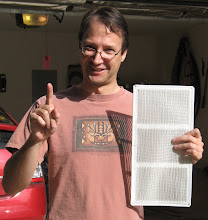Listen, dear readers, to something that is confusing to Energy Efficiency Man. I often read about energy efficiency measures in the press. Most of the articles written by reporters and policymakers talk about incentives or various combinations of steps homeowners can take, and if they mention numbers at all, they mention numbers like "9% energy reduction" or "20% savings". In fact, I can't recall a single press or government-authored article that I've read recently that mentions a number more than 30%. This New York Times article discussing recently released White House paper on "Cash for caulkers" goes so far as to estimate 28%. Now, as nice as 28% is as a savings, it simply doesn't grab the attention or change the terms of the energy discussion like a number greater than 50%.
However, as readers of my blog over the past few months have learned, I've personally experienced electric energy usage reduction of nearly 60% (in the literally hottest summer ever in Central Texas, mind you), and I've read articles by people who have actually done these things themselves, and the energy savings they typically mention are 50-75%.
My question: why are the people actually saving energy in the real world saving 50-75%, but the folks putting out most of the articles only think you can get 20%? To me, a 50% energy reduction is a game changer. With reductions like that, the current debate in my municipality about what to do with our stake in a local coal plant (which provides only 30% of our energy) becomes entirely moot. What to do about the coal plant? Shut it down - we wouldn't need it, and we don't want the 70% of our emissions that it produces. We could shut it down and still have an additional 50%-30%=20% spare capacity for population growth. (By the way, that is NOT one of the options under consideration by our city council - instead, we will likely spend tens of millions of dollars investing in making the coal plant "cleaner").
Are 50% savings like that too radical to make the press? If all energy users (homeowners, businesses, and governments) could achieve the savings the real-world Energy Efficiency enthusiasts have, we wouldn't need to build another coal plant, ever. We could achieve these energy savings, as I have in the very real world, by investing money borrowed at a typical rate of 5-10% for a rate of return between 20% and 40% according to my own experience. In effect, we could make money by saving energy. And of course, our rate of financial return would go up as the price of energy goes up.
Some of you may be familiar with Factor Four by Ernst Ulrich Weizsäcker, Amory B. Lovins, and L. Hunter Lovins. Energy efficiency enthusiasts will recognize Amory B. Lovins of the Rocky Mountain Institute, a policy think tank on energy issues. The book has been around for over a decade, and in it, the authors argue that based on real-world experience with industry and manufacturers, we are using energy at about 1/4th the efficiency that we could be. In effect, we could be doing 4x as much work as we are now with the same energy, or twice as much work using half the energy we use now, or the same amount of work using 25% of the energy that we use now, based on making improvements that pay for themselves in a manner timely enough to pay off the loan to make them. I would have to say that my own experience makes me think he is likely correct. There are still a few things that I'd like to do to my house that might get me to that magic 75% reduction, and although I've probably gathered most of the low-hanging fruit, there is more fruit to be gathered (probably mostly in replacing windows that are currently inexplicably surrounded by one of the most heat-conductive materials available, a fact which I still plan to discuss in a future post).
So why are we reading about all this work we have to do to save 20% at best, but folks actually doing it are saving 50%-75%? Comments welcome!
Subscribe to:
Post Comments (Atom)


No comments:
Post a Comment